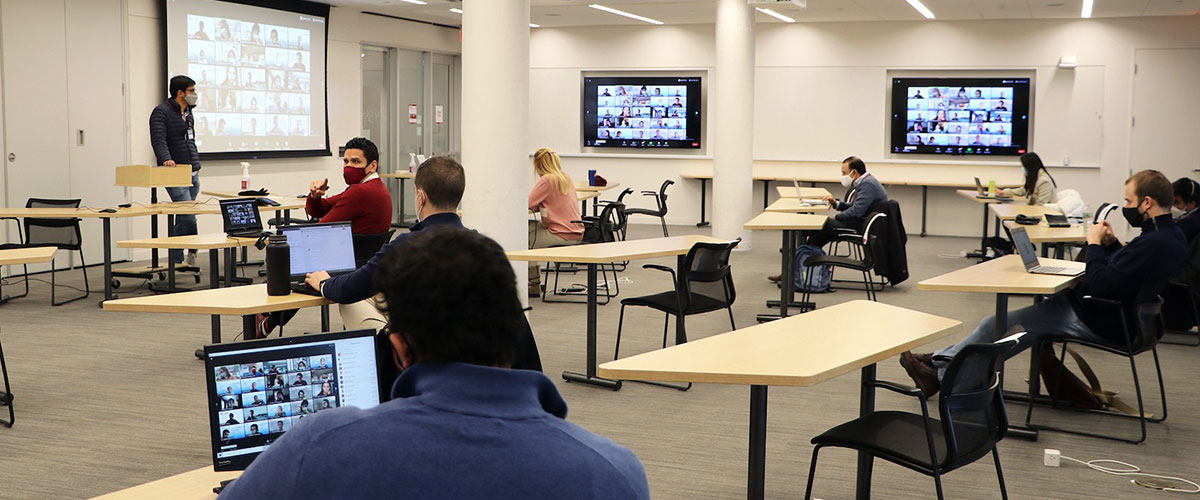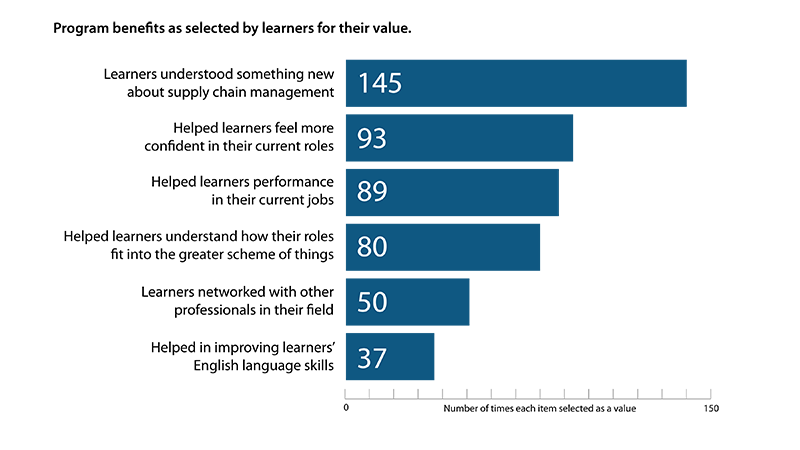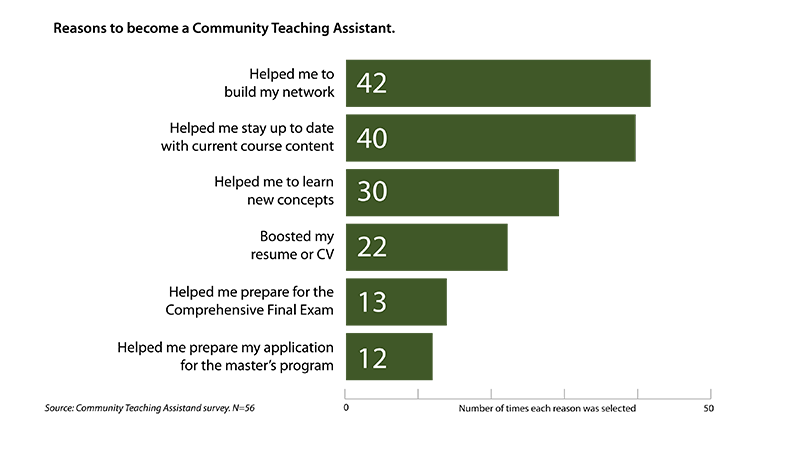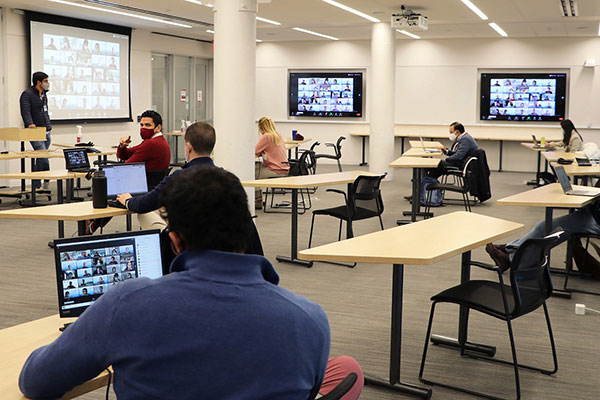Why Online Practitioner Communities Are a Valuable Professional Resource

Insights and resources for learning managers and educators on creating and nurturing communities.
The dramatic growth in online professional education owes much to the convenience and flexibility of the virtual classroom. However, a less recognized attribute of online learning programs–their community-building power–could prove to be an even more significant benefit of remote learning management.
Online professional development programs such as MicroMasters ® program credentials not only offer competency development for professionals; they also provide unique networking opportunities for the people participating in them. These communities support learning during their host education programs, and live on to function as dynamic professional resources for practitioners.
Engagement in online communities parallels MicroMasters program growth
Programs built using online learning management systems (LMS) provide an excellent foundation for the development of practitioner communities.
An intrinsic part of these programs is the communications infrastructure built into the LMS that is used for learning the material and communicating with other students and instructors. As the program grows and matures, this infrastructure underpins the growth of participant communities both within and outside the course programs.
The MITx MicroMasters program in Supply Chain Management created by the MIT Center for Transportation & Logistics provides a telling example of how this organic community growth takes place alongside a global professional development program.
Over the last six years, more than 400,000 learners from 196 countries — including some 40,000 who have paid to verify their identities and earn certificates upon passing the courses — have enrolled in the program.
During 2020 alone, the number of verified learners increased by an average of 84% over previous runs across all five courses in the program (for more on this trend see, Covid-Driven Shift to Online Education Fuels Supply Chain MicroMasters Growth).
As the MicroMasters program has grown — so has the number of alumni who remain actively involved in the learner community associated with the program. Currently, more than 2,600 credential holders belong to this community. These individuals, combined with those who are currently enrolled, comprise a vibrant, global community of supply chain professionals.
The results of a longitudinal survey circulated among program credential holders (N=157) show that learner networking with other professionals in their field was one of the top five reasons cited when asked about the benefits that learners appreciate most from completing their credential.

To support the growth of the online community, teaching and support staff have created several engagement channels for credential holders. Supported by MIT Open Learning offices, credential holders can participate in invitation-only discussion forums populated by their peers.
In addition, MIT CTL maintains monthly email updates and a LinkedIn meeting space for those learners who have completed the program. Because the in-course forums are no longer available once a course is completed, these meeting places and communications extend the learner's journey and allow for ongoing participation to evolve.
Credential holders may use their credentials to advance their careers, or as a pathway towards an accelerated master's at MIT. Those learners that progress in their careers tend to use the aforementioned online community forums to network for job opportunities, or to post jobs they are hiring for, and stay informed on new technology developments in the field.
A number of forum discussion threads center on emerging technologies. For those learners who go on to complete a semester at MIT, their forum use centers more on engagement with junior learners who are advancing through the program through offering academic advice or coaching on key concepts.
In addition to community engagement for credential holders, public forums and social media groups have been created to accommodate knowledge transfer and collaboration among all learners regardless of their progress through the program.
One such group on Facebook has grown to over 6,000 users. During 2020, nearly 5,000 people engaged in more than 700 posts, and there were nearly 20,000 interactions about topics ranging from current events to startup team building to course concept coaching.
A smaller, more intimate sub-community has also formed around the course and program delivery. The credential program enlists the help of Community Teaching Assistants (CTAs) to moderate the in-course discussion forums and answer fellow learner questions. At the time of this writing in April of 2021, 179 volunteers from 49 countries across 6 continents had contributed their time.
While the role is voluntary, the CTAs offer a vital service in maintaining discussion etiquette and interfacing with the teaching staff. A short experience survey was circulated among the community of CTAs in January of 2021. Building a network with like-minded individuals was reported as the most important benefit of being part of this community of volunteers.
The second and third most important benefits were staying connected with the course content and learning new concepts as they are introduced over time in course updates. For some of them, the CTA role boosted their resume while for others it helped them prepare for the program’s Comprehensive Final Exam (CFx). (see chart below). The CTA community, given its higher engagement and smaller size, is similar to communities that may form within corporate custom courses.

Custom courses for corporations can deliver unexpected benefits
MicroMasters program content is used to build custom supply chain courses for companies. MIT CTL has developed and implemented more than 20 custom courses for companies such as Walmart, AB InBev APAC, Ahold Delhaize, GE, and Shell. The benefits of online learner communities are also being captured within these companies.
These tailor-made programs create their own internal communities of associates, that function in much the same way as the broader MicroMasters program communities. Participants in the corporate groups exchange ideas and knowledge and gain a better understanding of each other’s functions and roles.
For example, an associate on a custom course created for a leading retailer commented that the program gives her an opportunity to “network with other supply chain associates in the company I would never have met because they are located all over the country.”
These exchanges need not be confined to the supply chain discipline. Companies are using custom courses to educate other functions on the ins and outs of supply chain management such as manufacturing, finance, and marketing to name a few. Thus, non-supply chain associates can use the custom course communities to network with their peers and continue to develop skills across disciplines.
Learning to build online communities founded on shared professional development
Delivering courses and programs both in public-facing massive open online courses (MOOCs) and within closed corporate courses has taught us much about building learner communities. The following are some lessons learned that may be useful for other educators and managers.
1. In-course and in-program activities to grow a community
- Within courses, both public and private, the discussion forums contribute to creating learning communities in MOOCs. Forums are the space for socializing and interacting with peers and the course team. Since 2014, MIT CTL has delivered 45 Supply Chain (SCx) courses, providing a high-touch experience through the use of forums to tens of thousands of learners. Forums are where learners network with a global and diverse pool of professionals, a cross-cultural sharing by people with vastly different backgrounds and academic experiences.
- While the program courses are delivered asynchronously, the teaching team creates “Live Events” — synchronous online events that help to connect the community of learners with the MIT teaching staff. These events allow for real-time Q&A with instructors. Learners also connect together through chat. In many live events, streams of learners share LinkedIn profile URLs in an effort to connect with their peers.
- The course team maintains weekly email newsletters throughout the course. Not only do these messages share vital course directions, but they also develop a sense of community by sharing demographic and progress information back to the learner group. Participants can better understand their progress and performance by viewing this aggregate reporting.
2. Cross-course and institute-wide activities and benefits to foster community
- The course team and support staff maintain several social media groups in order to give new learners a chance to mingle with more experienced individuals who have completed the program. In addition to the Facebook group mentioned above, MIT CTL hosts a private LinkedIn group for credential holders to foster professional networking.
- The course team and support staff create monthly newsletters for the extended community and for credential holders. Newsletters often share recent publications and industry developments along with community news. They may extend special offers to Center or network activities and events, further inviting learners into the broader supply chain community of practice.
- MIT as an institute commits to building an online community through the development of the MIT Open discussion forum. The online meeting space is designed to accommodate both public and private forums on a range of topics. This cross-course forum keeps learners connected to the community even after their course work is complete. The MicroMasters program in SCM was one of the first programs to create a Jobs forum for program participants who have completed one course or more. Both learners and staff can post jobs. The team also uses the forum to help facilitate learner-initiated meetups (below).
- Additionally, the institute contributes to credential-holder values and a sense of belonging by extending an array of benefits to program completers. Credential holders are designated as “Affiliate Alumni”. They receive online access to the MIT Libraries, as well as membership in curated subscription services like MIT Horizon.
3. Learner-initiated community building
- Motivated learners often reach out to others within courses or use cross-course forums to share social profiles or make connections. During the first four years of the program, learners would initiate local meetups. Through the Facebook group and the help of support staff, they convened in small groups in locations all over the world, for networking and maybe just to have a good time.
- Within custom corporate courses, where learners all may have access to internal communications tools, learners have met online and offline to create study support groups, or internal recruitment to enroll new associates into the program.
Community building within learning management comes at a cost
The accessibility, flexibility, and scalability of MOOCs enable them to be effective developers of practitioner communities. In the case of the Supply Chain Management MicroMasters program, developing course content, delivering it, and rigorously assessing learner progress requires a team effort from a large group of people.
Add to this the work required to grow the community and the resources needed to continually recreate this kind of learning and community content can quickly become a significant investment of resources. This is especially the case when the aim is to provide a high-touch experience through forums during and after courses are completed.
Community-building takes people and time. Unlike the educational content or a credential that both have clear educational and career benefits for learners, participating in a community may not have obvious or immediate benefits. For this reason, community interaction requires regular participation from course and support staff.
Within the MIT CTL, numerous social media groups have formed around other program offerings over the years. Without continual engagement, many of these groups become silent, empty backwaters in the digital stream of information.
An online community is only as valuable to its members as the flow of information and benefits of interaction it provides. It’s up to the community curators to set the standard and tone for this flow on official channels.
Online learners crave community and will start creating it themselves. Learner-initiated social groups and mini-communities sprout up all the time within the MicroMasters program. Most often within discussion forums, or during live synchronous events. As with the orphan staff-created groups mentioned above, most of these mini-communities receive intermittent support or guidance from their hosts.
When they do grow, they often compete with the official community channels, and may inadvertently spread disinformation about the course or program. Generally, the course team requests that these self-starting groups join one of the existing official channels or groups to avoid confusion and duplication of effort. It’s much more productive and beneficial to invest time and resources in providing an official, engaging, high-touch, and quality experience than to duplicate efforts to maintain self-starting groups.
Evaluating the online community as a valued professional resource
The benefits of online communities are not as measurable as the answers to exam questions. However, we believe that developing ways to quantify these benefits is vitally important to the future of professional education.
In addition to providing answers to learners’ questions, community platforms help to advance their careers and access job opportunities as well as offer new sources of knowledge. As we explain in this article, CTAs offer a vital example of individuals who learn from their peers by using community platforms to exchange ideas and know-how with other professionals.
Aside from being able to gauge these educational and career benefits, better ways to measure the value of community platforms will also help educators to resource them properly. The investments in money and personnel required to build, foster, and maintain communities of learners should not be underestimated. Moreover, these demands will increase as interest in the power of communities to enhance professional education grows.
More research on measuring the worth of community platforms to learners and educators is sorely needed.
Participate in our current Future of Education research, please fill this three to five-minute survey here.
Dr. Eva Ponce is the director of the MIT Center for Transportation & Logistics (MIT CTL) Omnichannel Education Lab. She also leads the Omnichannel Distribution Strategies and Circular Supply Chain initiatives at MIT CTL. For more information on those initiative’s research contact Eva at [email protected].
Arthur Grau is the Senior Communications Officer for MIT Center for Transporation & Logistics. He manages learner communications and engagement strategies.
Supply Chain 24/7 Education Resource Center
Find the latest educational resources, degrees, and programs.
Visit: Supply Chain 24/7 Education Resource Center
Article Topics
MIT Center for Transportation and Logistics News & Resources
Supply Chain’s Next Decade of Dealing With the Unknown Sustainability Efforts Continue to Ramp Up, Research Finds Supply Chain Sourcing Alternatives to China DAT’s Caplice Reviews Spot Market Strategy for 2024 Budget Planning Yellow’s Demise Underscores the Need for a New Labor Relations Narrative Is Your Supply Chain Talent Ready for the Future? The Rebound Podcast: Yossi Sheffi and The Magic Conveyor Belt More MIT Center for Transportation and LogisticsLatest in Business
U.S. Manufacturing is Growing but Employment Not Keeping Pace Women in Supply Chain: Ann Marie Jonkman of Blue Yonder The Two Most Important Factors in Last-Mile Delivery Most Companies Unprepared For Supply Chain Emergency Microsoft Unveils New AI Innovations For Warehouses Let’s Spend Five Minutes Talking About ... Malaysia TIm Cook Says Apple Plans to Increase Investments in Vietnam More Business













